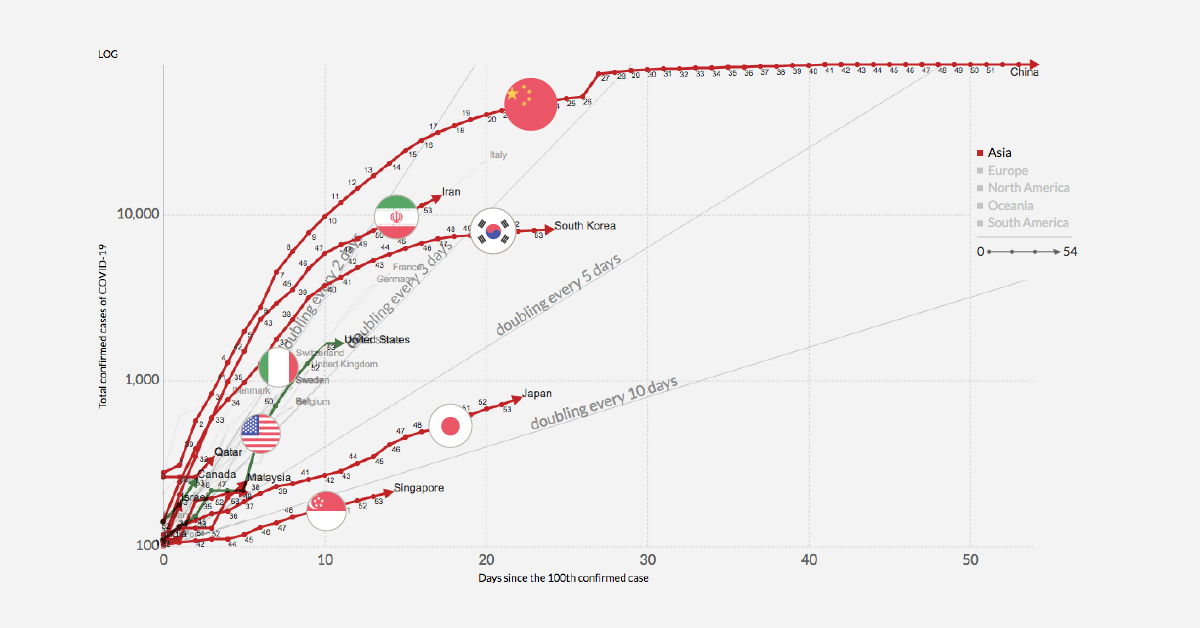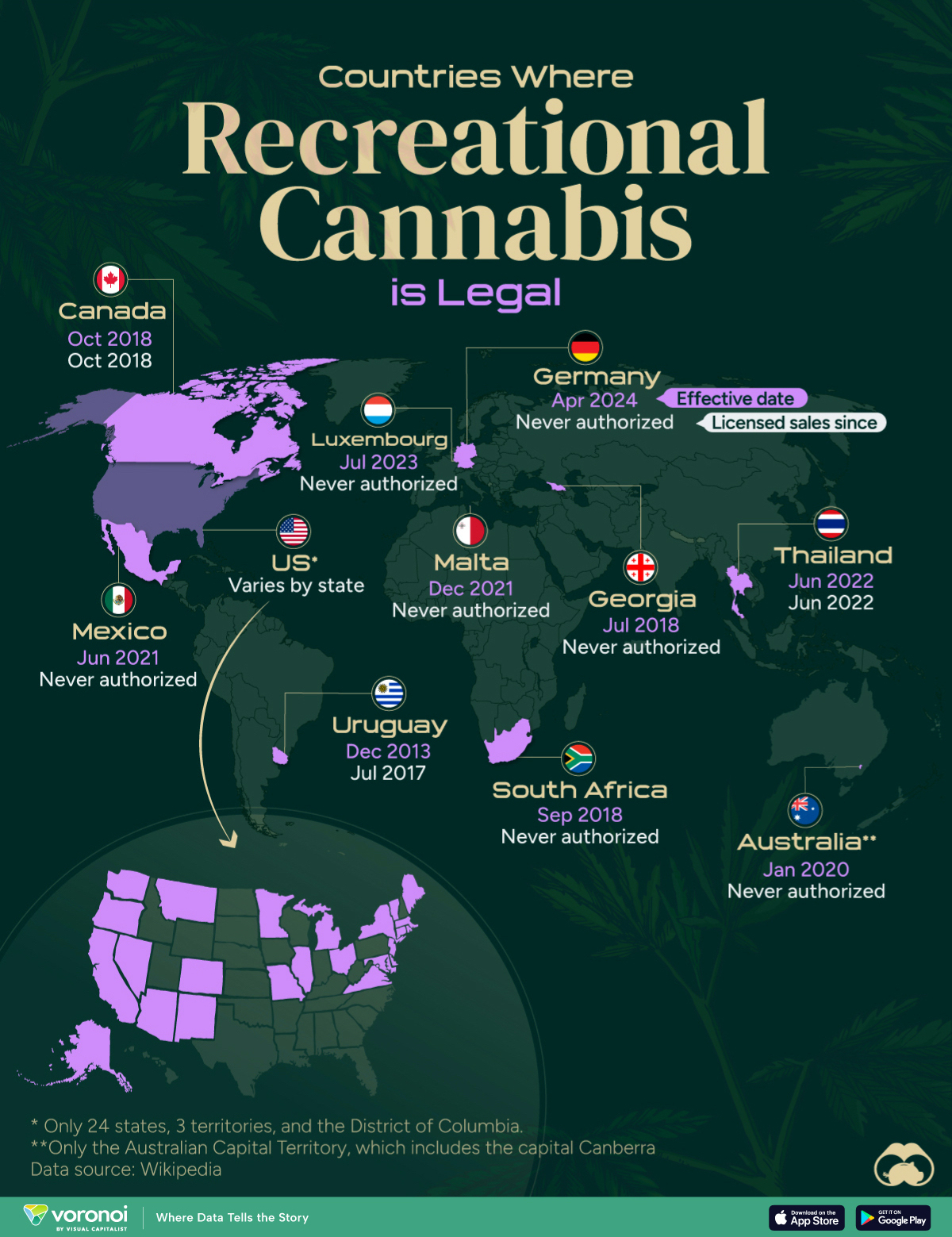Misc
Infection Trajectory: See Which Countries are Flattening Their COVID-19 Curve
NOTE: This chart updates daily with new data. Also, the search button in the lower–left corner allows filtering of specific countries.
At the outset of 2020, the world looked on as China grappled with an outbreak that seemed be spiraling out of control.
Two months later, the situation is markedly different. After aggressive testing and quarantine efforts, China’s outbreak of Novel Coronavirus (COVID-19) appears to be leveling off.
Now, numerous countries around the world are in the beginning stages of managing their own outbreaks. March 15th, 2020, marked a significant statistical milestone for this, as confirmed cases of COVID-19 outside of China surpassed the Chinese total.
The tracker above, by Our World in Data, charts the trajectory of the growing number of countries with more than 100 confirmed cases of COVID-19. As the number of new infections reported around the world continues to grow, which countries are winning the battle against COVID-19, and which are still struggling to slow the rate of infection?
What’s Your National Infection Trajectory?
As of publishing time, 39 countries have passed the threshold of 100 confirmed cases, with many more countries on the cusp. By comparing infection trajectories from the 100 case mark, we’re able to see a clearer picture of how quickly the virus is spreading within various countries.
A rapid “doubling rate” can spell big trouble, as even countries with advanced healthcare systems can become overwhelmed by the sheer number of cases. This was the case in the Lombardy region of Italy, where hospitals were overloaded and an increasing number of medical staff are under quarantine after testing positive for the virus. Nearly 10% of COVID-19 patients in Lombardy required intensive care, which stretched resources to their breaking point.
Other countries are looking to avoid this situation by “flattening the curve” of the pandemic. In other words, preventing and delaying the spread of the virus so that large portions of the population aren’t sick at the same time.
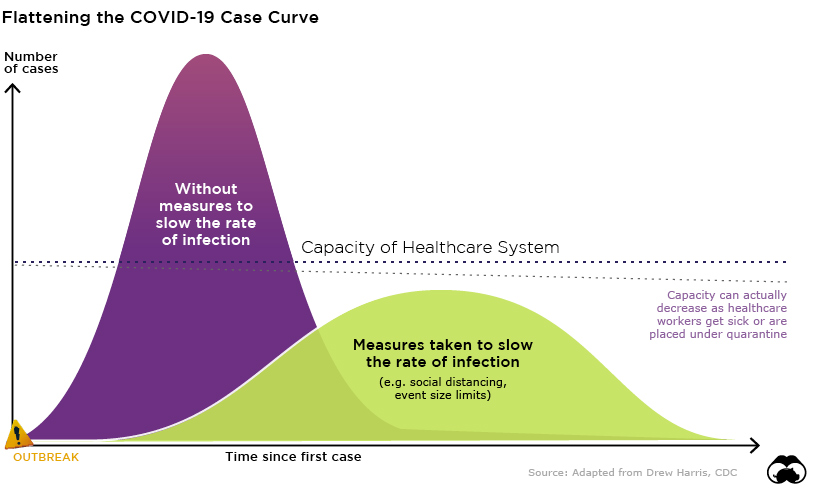
Original concept by Drew Harris
Everything’s Canceled
While all the countries on this tracker are united behind a common goal – stamping out COVID-19 as soon as possible – each country has its own approach and unique challenges when it comes to keeping their population safe. Of course, countries that are just beginning to experience exponential growth in case numbers have the benefit of learning from mistakes made elsewhere, and adopting ideas that are proving successful at slowing the rate of infection.
Many jurisdictions are implementing some or all of these measures to help flatten the curve:
- Quarantining
- Encouraging social distancing
- Encouraging working from home
- Closing schools and other institutions
- Placing hard limits on the size of crowds at events
The following chart explains why this last measure is critical to limiting the spread of the virus.

View the interactive Event Risk Assessment Tool here.
In scenario B above, which assumes just 20,000 active cases of COVID-19 in the U.S., there’s nearly a 50% chance an infected person will be attending a 10,000 person conference or sporting event. This is precisely the reason why temporary limits on crowd size are popping up in many jurisdictions around the world.
Direct losses due to canceled tech conferences alone, such as SXSW and the Electronic Entertainment Expo, have already surpassed the $1 billion mark, but despite the short-term economic pain of cancellations and decreased entertainment spending, the costs of business-as-usual could be incalculable.
United States
Mapped: Countries Where Recreational Cannabis is Legal
In total, only nine countries have fully legalized recreational cannabis use.
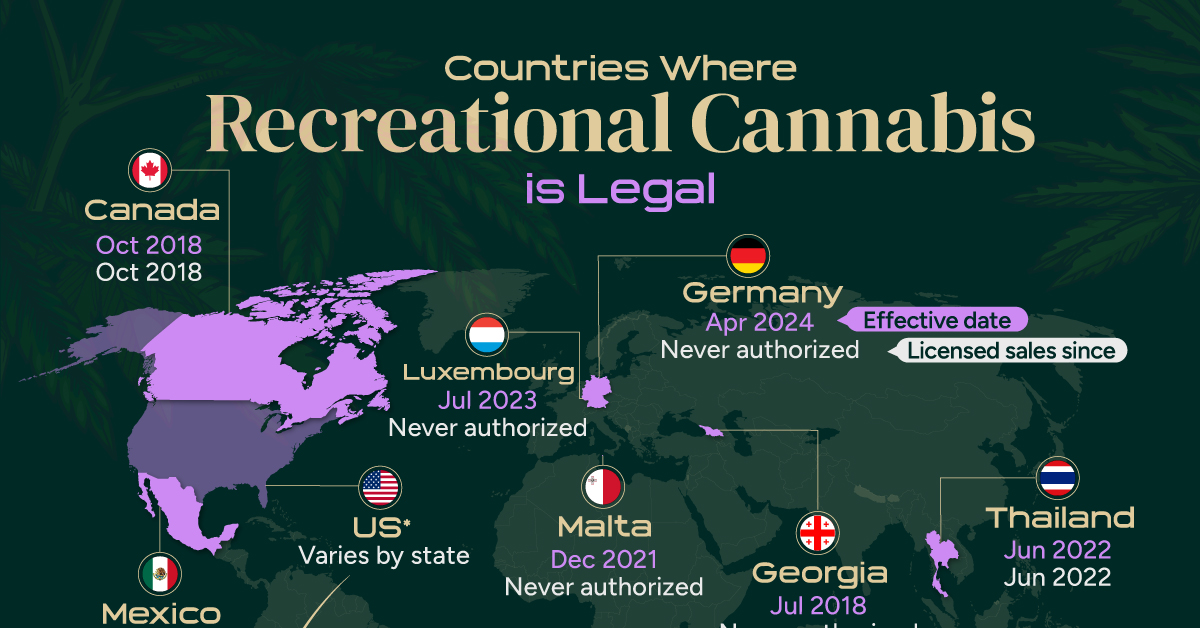
Countries Where Recreational Cannabis is Legal
This was originally posted on our Voronoi app. Download the app for free on iOS or Android and discover incredible data-driven charts from a variety of trusted sources.
In 2024, Germany became the third European Union country to legalize cannabis for personal use, following Malta and Luxembourg.
Here, we map the countries where recreational cannabis use is allowed as of April 2024, based on data from Wikipedia.
Limited to Few Countries
In total, only nine countries have legalized recreational cannabis use nationwide. However, just a few of them have licensed sales.
| Country | Effective date | Licensed sales since |
|---|---|---|
| 🇺🇾 Uruguay | December 2013 | July 2017 |
| 🇬🇪 Georgia | 30 July 2018 | Never authorized |
| 🇿🇦 South Africa | 18 September 2018 | Never authorized |
| 🇨🇦 Canada | 17 October 2018 | 17 October 2018 |
| 🇲🇽 Mexico | 28 June 2021 | Never authorized |
| 🇲🇹 Malta | 14 December 2021 | Never authorized |
| 🇹🇭 Thailand | 9 June 2022 | 9 June 2022 |
| 🇱🇺 Luxembourg | 21 July 2023 | Never authorized |
| 🇩🇪 Germany | 1 April 2024 | Never authorized |
| 🇺🇸 U.S. | Varies by state | Varies by state |
| 🇦🇺 Australia | Varies by jurisdiction | Never authorized |
At the federal level, cannabis is still considered an illegal substance in the United States. That said, individual states do have the right to determine their laws around cannabis sales and usage. Currently, cannabis is allowed in 24 states, 3 territories, and the District of Columbia.
Interestingly, the oldest legal text concerning cannabis dates back to the 1600s—when the colony of Virginia required every farm to grow and produce hemp.
Since then, cannabis use was fairly widespread until the 1930s when the Marihuana Tax Act was enforced, prohibiting marijuana federally but still technically allowing for medical use.
Today, the U.S. cannabis market is a $30 billion business. By the end of the decade, that number is expected to be anywhere from $58 billion to as much as $72 billion.
Similar to the U.S., Australia does not allow the use at the national level, but cannabis can be used legally in the Australian Capital Territory, which includes the capital Canberra.
-
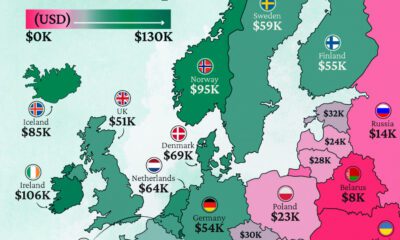
 Markets6 days ago
Markets6 days agoMapped: Europe’s GDP Per Capita, by Country
-

 Energy2 weeks ago
Energy2 weeks agoMapped: The Age of Energy Projects in Interconnection Queues, by State
-

 Mining2 weeks ago
Mining2 weeks agoVisualizing Global Gold Production in 2023
-
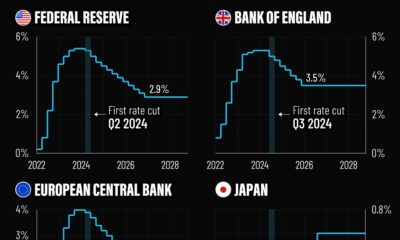
 Markets2 weeks ago
Markets2 weeks agoVisualized: Interest Rate Forecasts for Advanced Economies
-

 Economy2 weeks ago
Economy2 weeks agoThe Most Valuable Companies in Major EU Economies
-
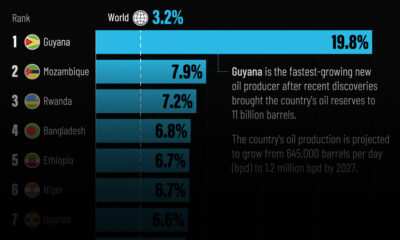
 Markets1 week ago
Markets1 week agoThe World’s Fastest Growing Emerging Markets (2024-2029 Forecast)
-
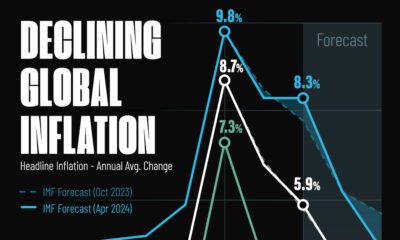
 Markets1 week ago
Markets1 week agoVisualizing Global Inflation Forecasts (2024-2026)
-
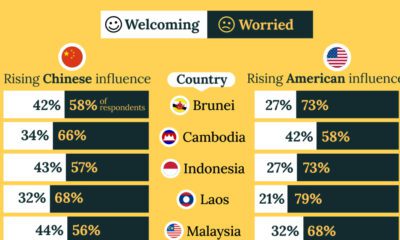
 United States1 week ago
United States1 week agoCharted: What Southeast Asia Thinks About China & the U.S.

